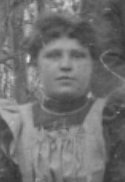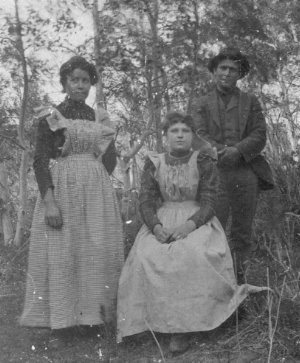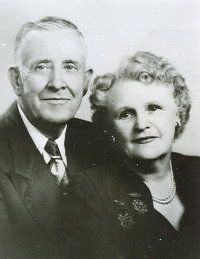 Mary Elizabeth Hadfield was born on July 13, 1882 in Glossop, Derbyshire, England, the first daughter of John Hadfield and Mary Shaw. She had three brothers and four sisters.
Mary Elizabeth Hadfield was born on July 13, 1882 in Glossop, Derbyshire, England, the first daughter of John Hadfield and Mary Shaw. She had three brothers and four sisters.
At the age of six, Mary attended the Church of England School, located in old Glossop. She attended full time until she was ten years old, then she went to school a half day and worked the other half as a weaver’s helper in a large cotton factory under her father’s supervision. At the age of fourteen she took an examination under one of Her Majesty’ Inspectors and passed with high honors. This was equivalent to a high school diploma at that time and she became a full time weaver, a job she kept until she came to America. The money she earned was given to her mother to help with the family expenses.
At this time, Mary was a member of the Church of England. All the members of the family belonged to this church except her mother. Her mother, Mary Shaw, had been baptized into the Mormon Church at the age of eight, her father having been one of the early converts in England.
When Mary was about eighteen years old there was a strike in the mill where her father worked. He became quite angry and quit the job and decided to move to America. Mary’s mother’s family was already in Utah and she was very anxious to join them. Mary had to quit her job to go along with her parents. Mary had no desire to leave Glossop. She had a good job, a comfortable home, friends, beautiful clothes, a boy friend, and just about anything a young girl could desire, but she was too young to leave behind, so her mother promised her she could return in a year if she didn’t like America. Mary agreed to go along with the rest of the family.
On May 11, 1900, they boarded a train for Glasgow, Scotland and the following day boarded the City of Rome for New York City.
Mary was a very beautiful girl with a peaches and cream complexion and soft brown hair. All the young men on board the ship wanted to make her acquaintance, a number of young missionaries returning home included. Mary’s knowledge of Mormons was not good. She thought she would be imprisoned behind a high wall if she had anything to do with them. Mary refused the young men’s attentions and stayed pretty much to herself. What could have been a really exciting voyage, turned out to be a rather lonely one.

Nell Toyn, Mary Hadfield Betteridge & Frank Morgan
After about fourteen days on the boat, they docked in the New York Harbor. They stayed in New York over night and the next day boarded a train for Utah. The ride was long and strange. There were wide stretches of plains and rivers.
Mary saw Negroes for the first time. The young black girls were dressed in white and carried fluffy parasols. This made quite a show for the young girls from England.
The family spent a few days in Ogden, Utah. This was about the middle of June and the mountains to the east of town still had snow on them. This was something new for all of them. The final part of the trip by train from Ogden was around the Great Salt Lake to a small railroad town called Terrace. Here they met Mary’s uncle, and he took them to Grouse Creek in a wagon pulled by a horse.
As the family approached the outskirts of the community, Mary’s Uncle said, “Well, here is the first house.” Mary looked around in dismay and answered, “I don’t see anything but cow sheds.” Everything was built of logs and had a dirt roof, it was hard to tell the difference between the houses and the sheds. Mary’s heart sank at the sight of their new community and the longing for her native land became stronger.
The family was very disappointed. They had left a fine home in England and had come to a desolate land where there was nothing but wide stretches of sage brush. At night they could hear the weird howl of the coyote. They couldn’t even see a light from a neighbor’s house and they really felt lost. England was a country with a mild climate and the fields were very green and lush. The meadows were full of wild flowers and the hedges took the place of fences. It was a beautiful country and was quite a contrast compared to Grouse Creek.
Work was very scarce and the family had a hard time making a go of it. Mary’s father and the older boys found work on farms and with livestock. Mary went to various places and did housework. The hours were long, the work very hard, and the pay small. The places she worked were miles from home and she saw very little of her family. Sometimes Mary was paid $1.50 a week. Other times her pay was old broken down furniture. One time she was given an old bedstead so full of bed bugs her mother refused to let her take it into the house.
Mary was very good at making bread. After working for a particular family in Terrace, it became known that she was a good bread maker, and she worked up quite a reputation in that community.
During the first summer she spent in Grouse Creek, Mary attended a Fourth of July celebration and dance in the ward hall. Her future father-in-law brought a young man up to her and said to him, “Here’s a young lady who would like to dance.” Mary had never learned to dance, but she was game and gave it a try. She learned to dance the square dance and the other dances of the time along with the best of the dancers.

William & Mary Betteridge
This young man, who had been trying his best to get acquainted with Mary, turned out to be her life companion. His name was William Cotton Betteridge. His parents, too, had emigrated from England and had helped to establish the community of Grouse Creek. Mary and the young man started to see a great deal of each other and two years later, they were married in the Salt Lake LDS Temple on October 3, 1902 for time and all eternity. Mary still had the desire to go back to England, but only for a visit. America was now her home.
Mary became very active in the LDS Church, having been baptized with her mother and sister in August 1900. She served as a teacher in Sunday School and Primary. She was president of the Y.L.MIA and president of the Grouse Creek Relief Society.
After moving to Ogden with her family she was a visiting sister in the Ogden 24th Ward. She has also spent much time doing temple work for her ancestors along with her husband.
They were married for sixty-four years and nine days when William died on October 12, 1966. Mary had a talent for nursing and took care of him for a long time before his death.
Just a few days prior to her ninety-seventh birthday Mary’s hip crumbled with her, resulting in stays in the hospital and convalescent home. On October 6, 1979, she passed away in her sleep after several weeks of suffering.
